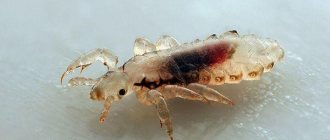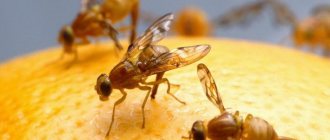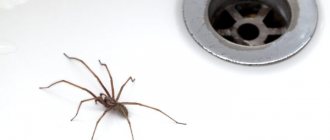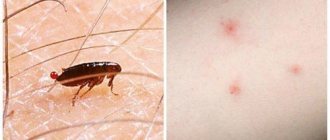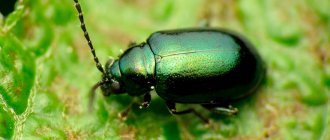In this material, prepared by sanitary service specialists SES 4 DEZ, you will find answers to the following questions:
- What do house fleas look like?
- What do fleas eat?
- How fleas reproduce;
- Where do fleas come from indoors?
- Where do fleas live in the house?
- Where do fleas live on the street?
- What do flea bites look like?
- Why are flea bites dangerous?
- Prevention against fleas;
- Methods for killing fleas.
If you wanted to call a health service to exterminate fleas, go to this page.
Fleas infest indoors by being carried by people or pets on their clothing or fur. They are quite difficult to notice due to their small size, but their presence can be clearly determined by their bites - they are very painful. At the moment, more than 2000 species of fleas are known, while more than 500 live in Russia.
Domestic flea in profile
What do fleas look like?
Fleas are wingless parasites that are reddish-brown in color. The average length of an individual is 2.5 mm, and can reach 4 mm in length. They have microscopic hair. The bodies are flat. Due to their 6 elongated legs, they can jump long distances - up to 33 cm in length. The claws located on the paws provide them with grip on the fur and body of animals. The mouthparts are of the piercing-sucking type.
It is quite difficult to kill a flea with a simple object or a clap of the palm due to their small size
Professional pest control
Calling a special service will require money, but only in this case the effect will really be long-lasting and guaranteed. At the first visit, the specialist will inspect, assess the situation and set a treatment time for which the room will need to be prepared.
Disinsection is carried out in one of three ways:
- fine spraying;
- hot fog;
- cold fog.
The most budget option is fine-droplet spraying. During the disinfestation process, the solution is sprayed using an electric or mechanical sprayer.
When treating with cold or hot fog, irrigation is carried out using a generator, during which fleas and their larvae die almost instantly. The difference in the methods is in the temperature of the insecticide solution. Hot fog is more effective due to the heat factor, to which insects are sensitive, but can damage furniture, clothing or room decoration.
What do fleas eat?
Fleas are blood-sucking parasites. First of all, they prefer to feed on the blood of animals with thick hair - dogs, cats, rabbits, squirrels, rats, mice and other domestic and wild animals.
Despite the fact that fleas are divided by type depending on their food source (for example, cat fleas, dog fleas), all fleas bite people. During a bite, saliva is injected into the wound, which contains an analgesic substance, which prevents the immediate detection of the bite, but later irritation and itching appear.
Adults detect their victims by movement, vibrations and respiration (changes in heat and humidity in the air).
Fleas in a dog's fur
Pet hair
Among those that cause us the most trouble are dog, cat, rat and human fleas. Despite their distinctive names, these species can feed on the blood of any warm-blooded animal, including humans.
Animal fur is obviously the most preferred habitat for a flea. But how much time she spends there is influenced by species and age. Adult fleas spend 50 to 90% of their time on their host. They use strong limbs to grab onto the animal's fur and settle there. The food source is thus always nearby. After all, without regular feeding, female fleas will not be able to lay eggs.
If you try to catch a flea on a pet, it will use all its abilities to dodge and stay on its host.
How to get rid of fleas on pets
If fleas live only on a pet, you can get rid of them simply by treating the animal with a special remedy - tablets, anti-flea shampoos, collars, drops, etc. However, it may happen that this will only kill the adult fleas, while individuals from other stages of the flea life cycle that are outside the animal's fur will survive.
How fleas reproduce
Fleas go through three stages of development: egg, larva, imago (adult). Going through all stages of the cycle takes from several weeks to several months. The speed of development depends on living conditions.
Egg
Flea eggs are also very small
Fleas lay eggs in waste and dust that accumulate in rooms, houses and animal beds. Unlike many other insects, fleas do not carry their offspring with them.
They lay two to thirteen eggs after eating. The female lays the largest number of eggs in the last days of her life. Unlike the eggs of other parasites, flea eggs are not sticky and simply fall to the ground after being laid.
The process of developing an egg into a larva takes about 12 days, with most eggs hatching within a few days.
Larva
Detection of larvae in places where dust accumulates is very difficult due to their size
Flea larvae are white transparent, from 3 to 5.2 mm in length. The body darkens as it absorbs food. The larvae have a worm-like appearance and molt twice during their life cycle. The larval stage can take up to 18 days, after which the larva is wrapped in a silky cocoon and enters the pupal stage. The pupal stage can be completed in three days or even last up to a year.
Unlike adults, larvae do not feed directly from the food source, but consume organic matter: food crumbs, dead skin, dead insects, pieces of fur, and primarily the excrement of adults - they contain undigested blood. The larvae are born blind and detect adults by their excrement, a sign that a food source is nearby.
After hatching from the egg, the larvae look for shelter - cracks, gaps and crevices in the floor, under furniture, and bed.
Imago (adults)
Adults move quickly through space until they find a food source
After hatching from the cocoon, adults begin searching for food sources. At first, they can be detected by moving around the apartment, but after detecting a food source (animal), they remain there. Females begin laying eggs within 48 hours of feeding, thus restarting the life cycle of future individuals.
Reproduction and development
Under favorable environmental conditions, fleas reproduce all year round. At extremely low temperatures, fleas will survive without problems, but will not reproduce. Also, for successful reproduction, both partners must be well-fed; hungry fleas will not reproduce.
During sexual intercourse, the female climbs onto the male's back and pulls his genital claw into her spermatic receptacle. Interestingly, sexual intercourse in fleas can last several hours, while it takes 10-15 minutes to transfer the seed to fertilize the female.
Some time after fertilization, the female lays eggs, which pass in small portions. Typically, fleas lay 1-2 servings of 4-10 eggs per day. The process of laying eggs itself is very curious: the female forcefully pushes out the eggs, which sometimes fly considerable distances from each other. This position of the eggs makes sense, since competition between the hatched larvae subsequently decreases.
Routes of infection
Fleas are brought indoors either by pets or by rats and mice, where they fall from dirt and leaves lying on the ground. Once indoors, they will settle on carpets, furniture, house plants, and draperies. A warm and humid habitat is ideal for them. Cold temperatures slow down their life cycle, so summer is the ideal time for them to reproduce and develop.
Fleas can also migrate from neighboring infested premises, from building basements and entrances.
Where do fleas live
Depending on the stage of development, fleas can be found in different places.
- The eggs are laid directly in the animal's fur, where they fall down carpets/upholstery/furniture/floor cracks in the floors and crevices in the walls. They go through their developmental stage in these secluded places, from where, having become an imago, they return to animals again.
- The larvae love narrow, inaccessible, dark and dusty places, which provide them with safety during their development. Flea pupae can only be found in the area of floors and carpets.
- Adults spend most of their time on food sources—animals with fur.
Where do fleas live on the street?
Fallen leaves, grass in the shade under bushes and trees are ideal places to attack animals
Outdoors, fleas live in tall grass, sand, garbage and other places where they can find shelter and where there is sufficient moisture. Therefore, tall grass in the bush area is ideal for them to go through all three stages of development. In addition, animals often like to hide in the shade on hot days - exactly in those places where fleas live.
Habitats
Where do fleas live? Strong, hardy, these insects are common everywhere, even in cold
Antarctica, where they can successfully parasitize the same penguins and seals. Most of their species live in the temperate and subtropical zones of Europe, Asia, Africa, and the Americas. Fleas are active at any time of the year. They usually live near the nests and burrows of their potential donors: warm-blooded animals.
What do flea bites look like?
Externally, flea bites are similar in many ways to mosquito bites, but they take much longer to heal. Flea bites, unlike tick or ant bites, have only one puncture. Within half an hour, the bite site swells, turns red and itches very much. After one or two days, the area turns into a small wound or abscess and may even bleed.
What distinguishes flea bites from bedbug bites is their chaotic location.
Flea prevention
- regular examination of pets;
- regular brushing and washing of animals;
- regular inspection of the premises: carpets, draperies, furniture, animal beds, in rare cases - bed linen if you allow animals on the bed;
- vacuuming all hard-to-reach places, especially cracks and breaks in the floor, eliminating dust accumulations in the apartment;
- washing and drying animal bedding.
Cold living conditions lead to the fact that the larvae die without going through the pupation stage. Humidity below 45% will also cause death.
Methods for killing fleas
Fleas are resistant to most insecticides, but preparations containing fipronil, fluvalinate, cypermethrin, and cyfluthrin are effective. Also, to combat fleas, insecticidal preparations based on FOS (chlorophos, karbofos, fenthion), carbamate (propoxur), pyrethroids (permethrin, deltamethrin, cypermethrin, fenvalerate, cyphenothrin), neonicotinoids, etc. are used. A complete list of drugs used by our service for extermination fleas, written in simple language, can be found here. You can read instructions on how to kill insects yourself here.
To order the destruction of fleas in apartments and premises in St. Petersburg and the Leningrad region, call: 8
Video
Author: Pavel Chaika, editor-in-chief of Poznavaika magazine
When writing the article, I tried to make it as interesting, useful and high-quality as possible. I would be grateful for any feedback and constructive criticism in the form of comments on the article. You can also write your wish/question/suggestion to my email [email protected] or Facebook, with respect, the author.
Author page
This article is available in English -
Fleas.


